Rectangular Microstrip Array Feed Antenna for C-Band Satellite Communications: Preliminary Results
Abstract
:1. Introduction
2. Antenna Design
3. Antenna with Reflector: Simulation Results
4. Conclusions and Future Work
Author Contributions
Funding
Data Availability Statement
Conflicts of Interest
References
- Ritronnasak, R.; Charoenpru, T.; Waranon, L. Integration and Installation of The Low Cost C-band Receiving System for Himawari-8 Satellite. In Proceedings of the 2018 15th International Conference on Electrical Engineering/Electronics, Computer, Telecommunications and Information Technology (ECTI-CON), Chiang Rai, Thailand, 18–21 July 2018; pp. 732–735. [Google Scholar]
- Sun, H.; Zhang, F.; Jia, C. Research on Key Technologies of C/Ku Dual-Band Satellite Communication. In Proceedings of the 2019 International Conference on Robots & Intelligent System (ICRIS), Haikou, China, 15–16 June 2019; pp. 149–151. [Google Scholar]
- Hashmi, R.M.; Esselle, K.P. Planar high-gain antennas for direct broadcast satellite reception. In Proceedings of the 2016 IEEE 2nd Australian Microwave Symposium (AMS), Adelaide, SA, Australia, 11–12 February 2016; pp. 17–18. [Google Scholar]
- Kumar, C.; Reddy, B.S.; Kumar, B.P.; Kumar, V.S.; Srinivasan, V.V. Novel high gain dual band single aperture array with large cross-polarized isolation at Ku-band for the TT&C system of a geostationary satellite. In Proceedings of the 2017 IEEE International Conference on Antenna Innovations & Modern Technologies for Ground, Aircraft and Satellite Applications (iAIM), Bangalore, India, 24–26 November 2017; pp. 1–5. [Google Scholar]
- Kumar, C.; Puram, V.S.; Kumar, V.S.; Venkataramana, D. Design Consideration of High Gain Microstrip Antenna Arrays for Telemetry Tracking and Command System of Geostationary Satellites. In Proceedings of the 2018 IEEE Indian Conference on Antennas and Propogation (InCAP), Hyderabad, India, 16–19 December 2018; pp. 1–3. [Google Scholar]
- Thaker, N.M.; Ramamoorthy, V. A Review on Circular Microstrip Patch Antenna with Slots for C Band Applications. Int. J. Sci. Eng. Res. 2014, 5, 1039–1043. [Google Scholar]
- Abdulhameed, M.K.; Isa, M.; Zakaria, Z.; Mohsin, M.K.; Attiah, M.L. Mushroom-Like EBG to Improve Patch Antenna Performance for C-Band Satellite Application. Int. J. Electr. Comput. Eng. 2018, 8, 3875–3881. [Google Scholar] [CrossRef]
- Dahri, F.A.; Soomro, R.A.; Memon, S.A.; Memon, Z.; Memon, M.H. An Optimized Inset Feed Circular Cross Strip Antenna Design for C-Band Satellite Links. Int. J. Adv. Comput. Sci. Appl. 2018, 9, 238–242. [Google Scholar] [CrossRef] [Green Version]
- Sran, S.S.; Sivia, J.S. Quad Staircase Shaped Microstrip Patch Antenna for S, C and X Band Applications. Procedia Comput. Sci. 2016, 85, 443–450. [Google Scholar] [CrossRef] [Green Version]
- Singh, S.; Sahayam, N. New 2GHz Broadband Microstrip Patch Antenna for C-band Pervasive Wireless Communication. Int. J. Eng. Sci. Adv. Technol. 2012, 2, 971–974. [Google Scholar]
- e Munir, M.; Mahmood, K.; Khan, M. E-Shape Patch Antenna For Mobile Phone, S-Band and C-Band Applications. J. Mech. Contin. Math. Sci. 2018, 13, 115–127. [Google Scholar] [CrossRef]
- Debbarma, K.; Bhattacharjee, R. Microstrip patch antenna feed for offset reflector antenna for dual band application. Int. J. Microw. Comput. Aided Eng. 2019, 29, e21999. [Google Scholar] [CrossRef]
- Qudrat-E-Maula, M.; Shafai, L. Low-Cost, Microstrip-Fed Printed Dipole for Prime Focus Reflector Feed. IEEE Trans. Antennas Propag. 2012, 60, 5428–5433. [Google Scholar] [CrossRef]
- Mohamed, N.; Mohamad, S.Y.; Farihah Abdul Malek, N.; Mohd Isa, F.N. A Compact and Lightweight Microstrip Antenna Array with Wilkinson Power Divider for X-band Application at 9.5 GHz. In Proceedings of the 2019 IEEE Asia-Pacific Conference on Applied Electromagnetics (APACE), Malacca, Malaysia, 25–27 November 2019; pp. 1–5. [Google Scholar]
- Bhattacharjee, R.; Debbarma, K. Analysis of offset reflector performance fed by 2×2 microstrip antenna array using GO technique. In Proceedings of the 2018 3rd International Conference on Microwave and Photonics (ICMAP), Dhanbad, India, 9–11 February 2018; pp. 1–2. [Google Scholar]
- Jha, K.R.; Sharma, S.K. Waveguide integrated microstrip patch array feed source for a reflector antenna at THz frequency. In Proceedings of the 2014 IEEE Antennas and Propagation Society International Symposium (APSURSI), Memphis, TN, USA, 6–11 July 2014; pp. 1465–1466. [Google Scholar]
- Nagasaka, M.; Nakazawa, S.; Tanaka, S. Prototype of a dual-circularly polarized parabolic reflector antenna with microstrip antenna array for 12-GHz band satellite broadcasting reception. In Proceedings of the 2016 10th European Conference on Antennas and Propagation (EuCAP), Davos, Switzerland, 10–15 April 2016; pp. 1–5. [Google Scholar]
- Nagasaka, M.; Nakazawa, S.; Tanaka, S. Dual-circularly polarized parabolic reflector antenna with microstrip antenna array for 12-GHz band satellite broadcasting reception. In Proceedings of the 2016 International Symposium on Antennas and Propagation (ISAP), Okinawa, Japan, 24–28 October 2016; pp. 692–693. [Google Scholar]
- Hasan, M.; Seo, M. High-gain 2 × 2 UWB antenna array with integrated phase inverter. Electron. Lett. 2018, 54, 612–614. [Google Scholar] [CrossRef]
- Mei, L.; Zhang, N.; Liu, L.; Wang, D.; Ma, Y.; Li, Y.; Jiao, X.; Guo, Y. A C-band 16×16 array antenna for microwave communication. In Proceedings of the 2016 11th International Symposium on Antennas, Propagation and EM Theory (ISAPE), Guilin, China, 18–21 October 2016; pp. 299–302. [Google Scholar]
- Reynalda, T.; Munir, A.; Bharata, E. Characterization of 4×4 high gain microstrip array antenna for 3.3 GHz WiMAX application. In Proceedings of the 2011 6th International Conference on Telecommunication Systems, Services, and Applications (TSSA), Denpasar, Indonesia, 20–21 October 2011; pp. 215–218. [Google Scholar]
- Mariyanto, A.S.S.; Irfan, M.; Ariessaputra, S.; Mustiko, O.M.C. Design and realization of microstrip antenna for GPS application using proximity coupled techniques. In Proceedings of the 2017 11th International Conference on Telecommunication Systems Services and Applications (TSSA), Lombok, Indonesia, 26–27 October 2017; pp. 1–4. [Google Scholar]
- Widiandari, R.; Munir, A. Proximity coupled x-band patch antenna array with dual polarization. In Proceedings of the 2016 International Electronics Symposium (IES), Denpasar, Indonesia, 29–30 September 2016; pp. 165–168. [Google Scholar]
- Bakariya, P.S.; Dwari, S.; Sarkar, M.; Mandal, M.K. Proximity-Coupled Multiband Microstrip Antenna for Wireless Applications. IEEE Antennas Wirel. Propag. Lett. 2015, 14, 646–649. [Google Scholar] [CrossRef]
- Bakariya, P.S.; Dwari, S.; Sarkar, M.; Mandal, M.K. Proximity-Coupled Microstrip Antenna for Bluetooth, WiMAX, and WLAN Applications. IEEE Antennas Wirel. Propag. Lett. 2015, 14, 755–758. [Google Scholar] [CrossRef]
- García-Marín, E.; Masa-Campos, J.; Sánchez-Olivares, P. 4 × 4 stacked patch array with siw and microstrip corporate feeding network for ku-band. In Proceedings of the 2016 10th European Conference on Antennas and Propagation (EuCAP), Davos, Switzerland, 10–15 April 2016; pp. 1–4. [Google Scholar]
- Zhang, Y.; Zheng, H.; Gao, B.; Tang, C.; Liu, R.; Wang, M. A Compact Dual-band Antenna for 5G Application. In Proceedings of the 2019 Cross Strait Quad-Regional Radio Science and Wireless Technology Conference (CSQRWC), Taiyuan, China, 18–21 July 2019; pp. 1–2. [Google Scholar]
- Han, Y.n.; Zheng, Z.x.; Sun, A.m. Optimizing antennas distribution on complicated structures by conformal finite-difference time domain. In Proceedings of the 2012 6th Asia-Pacific Conference on Environmental Electromagnetics (CEEM), Shanghai, China, 6–9 November 2012; pp. 54–57. [Google Scholar]
- Islam, M.T.; Anika, N.U.; Mahmud, M.; Islam, M.; Abir, M.H.; Chy, M.H. Design of a Microstrip Patch Antenna for both C-band and X-band Applications. In Proceedings of the 2020 2nd International Conference on Advanced Information and Communication Technology (ICAICT), Dhaka, Bangladesh, 28–29 November 2020; pp. 7–10. [Google Scholar]
- Juarez-Ortiz, V.A.; Perea-Tamayo, R. Design of a C-band High Gain Microstrip Antenna Array for CubeSat Standard. In Proceedings of the 2018 IEEE MTT-S Latin America Microwave Conference (LAMC 2018), Arequipa, Peru, 12–14 December 2018; pp. 1–3. [Google Scholar]
- Zaman, M.R.; Islam, M.T.; Misran, N.; Mandeep, J.S. Analysis of Resonance Response Performance of C-Band Antenna Using Parasitic Element. Sci. World J. 2014, 2014, 131374. [Google Scholar] [CrossRef] [Green Version]



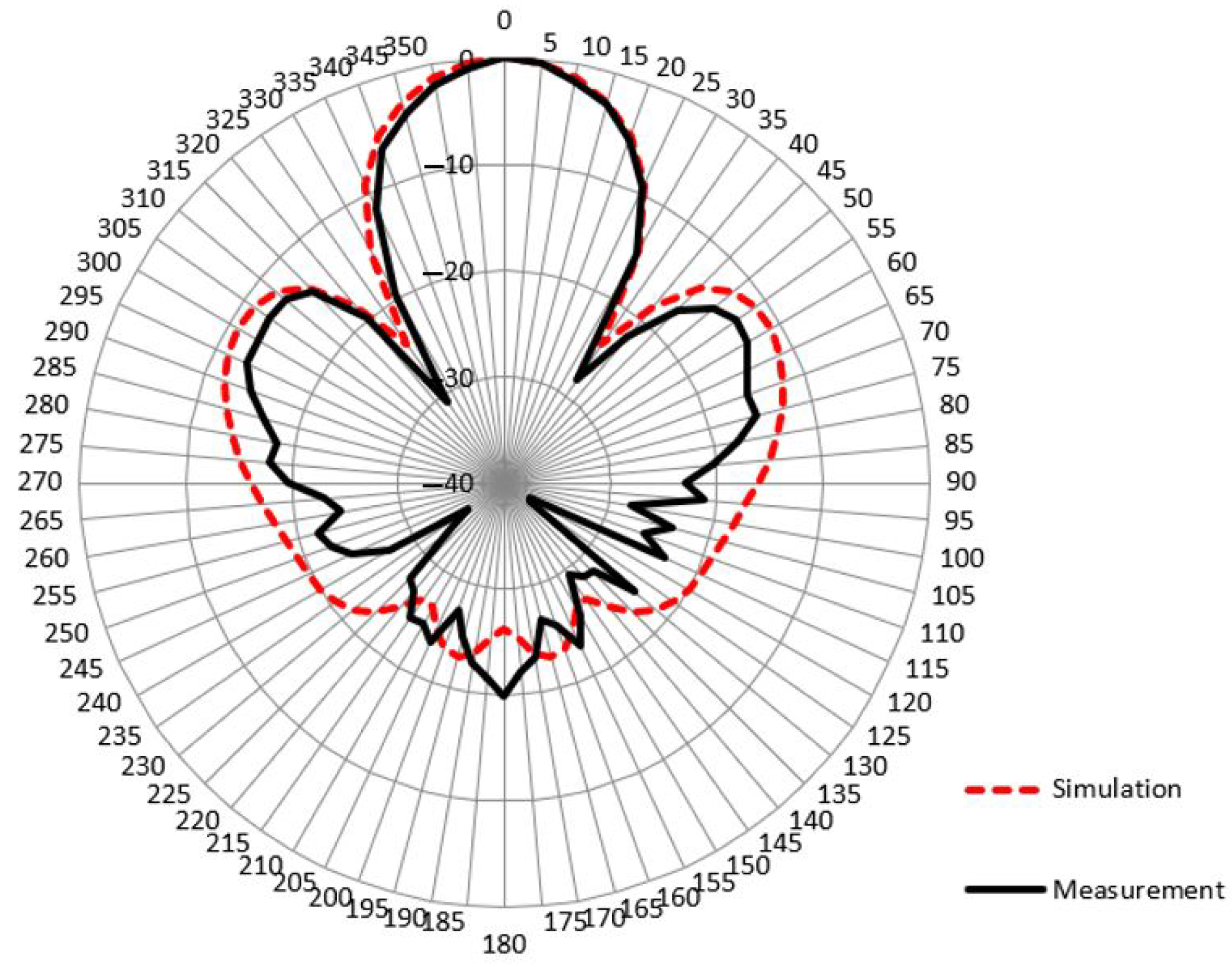
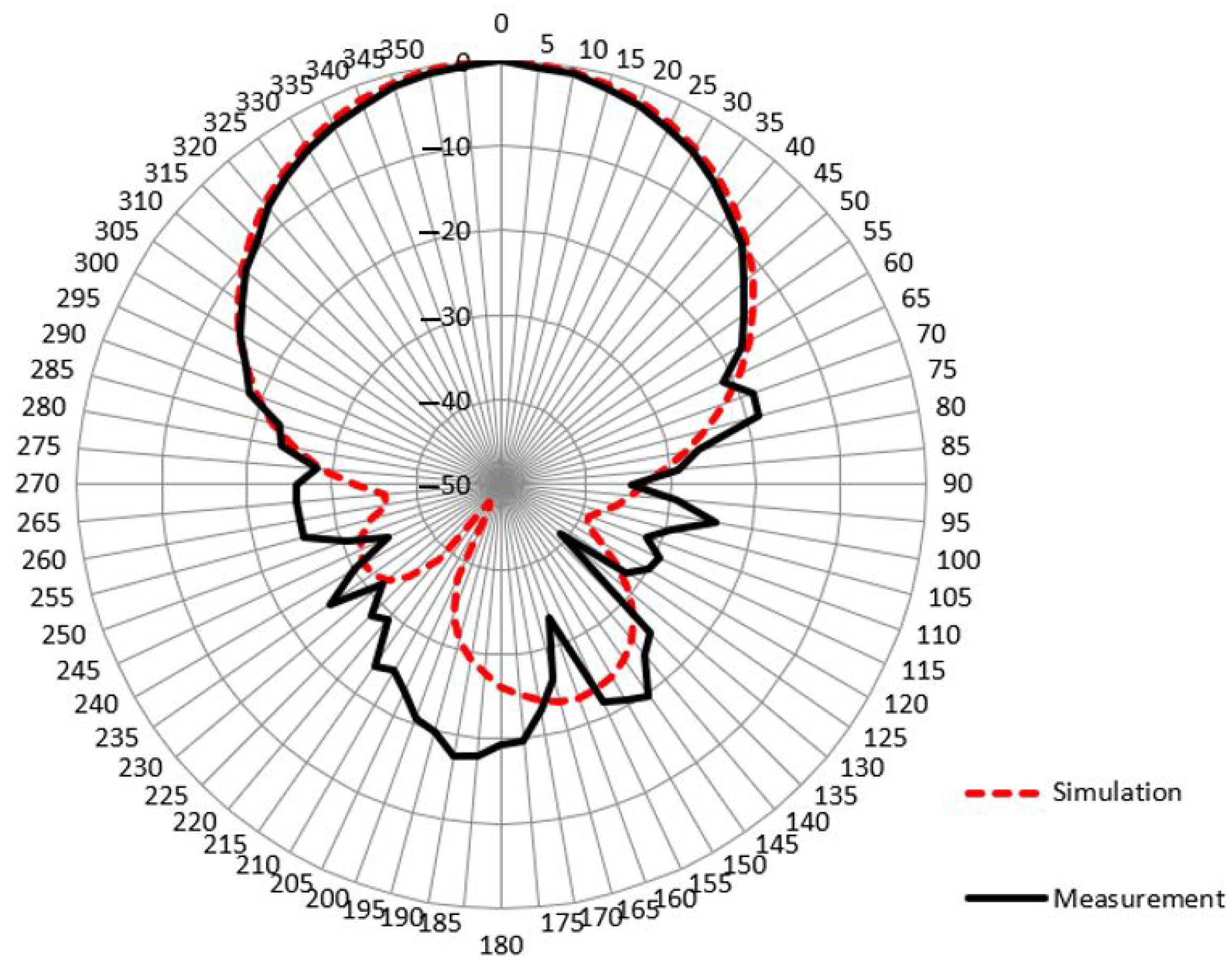

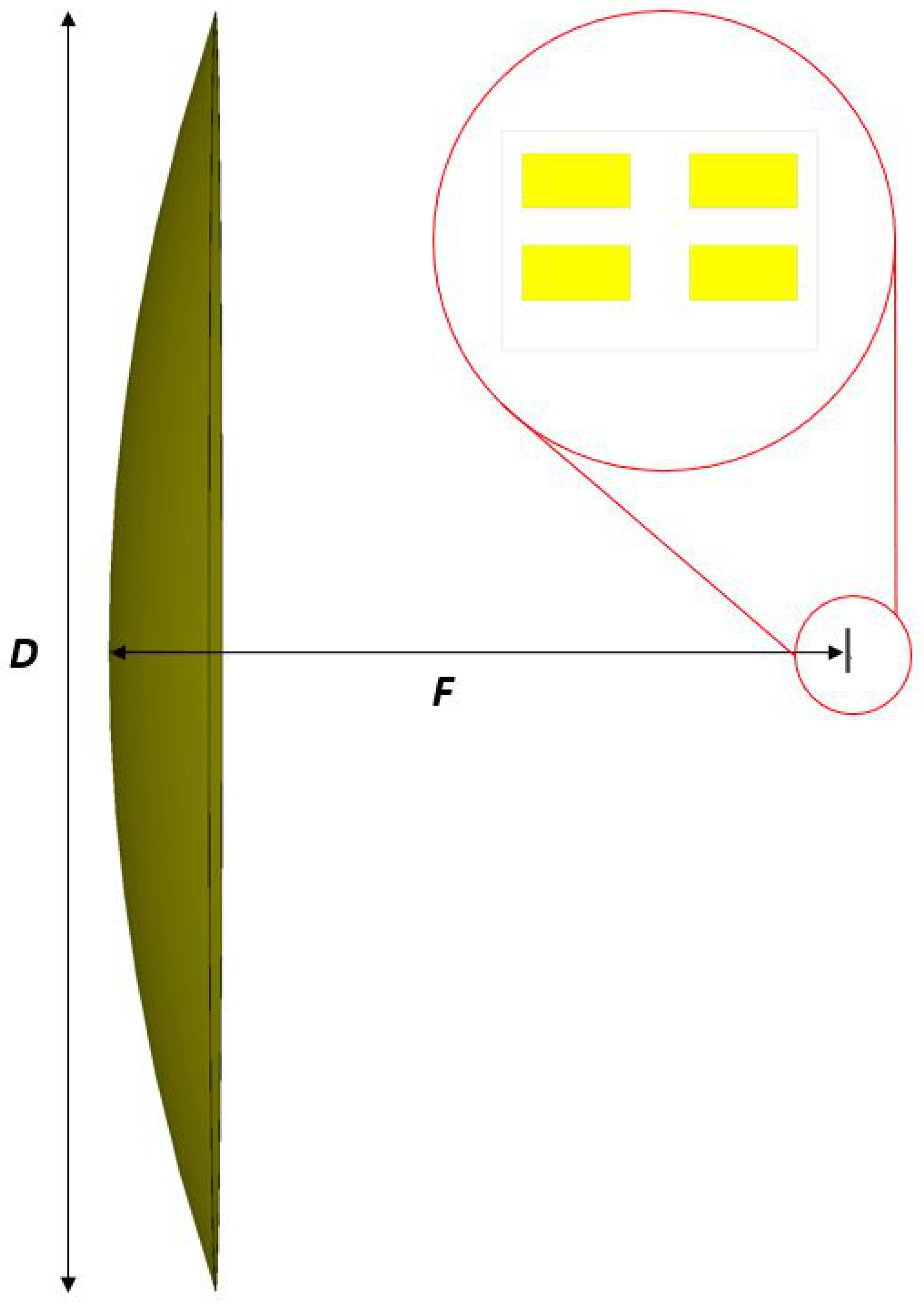
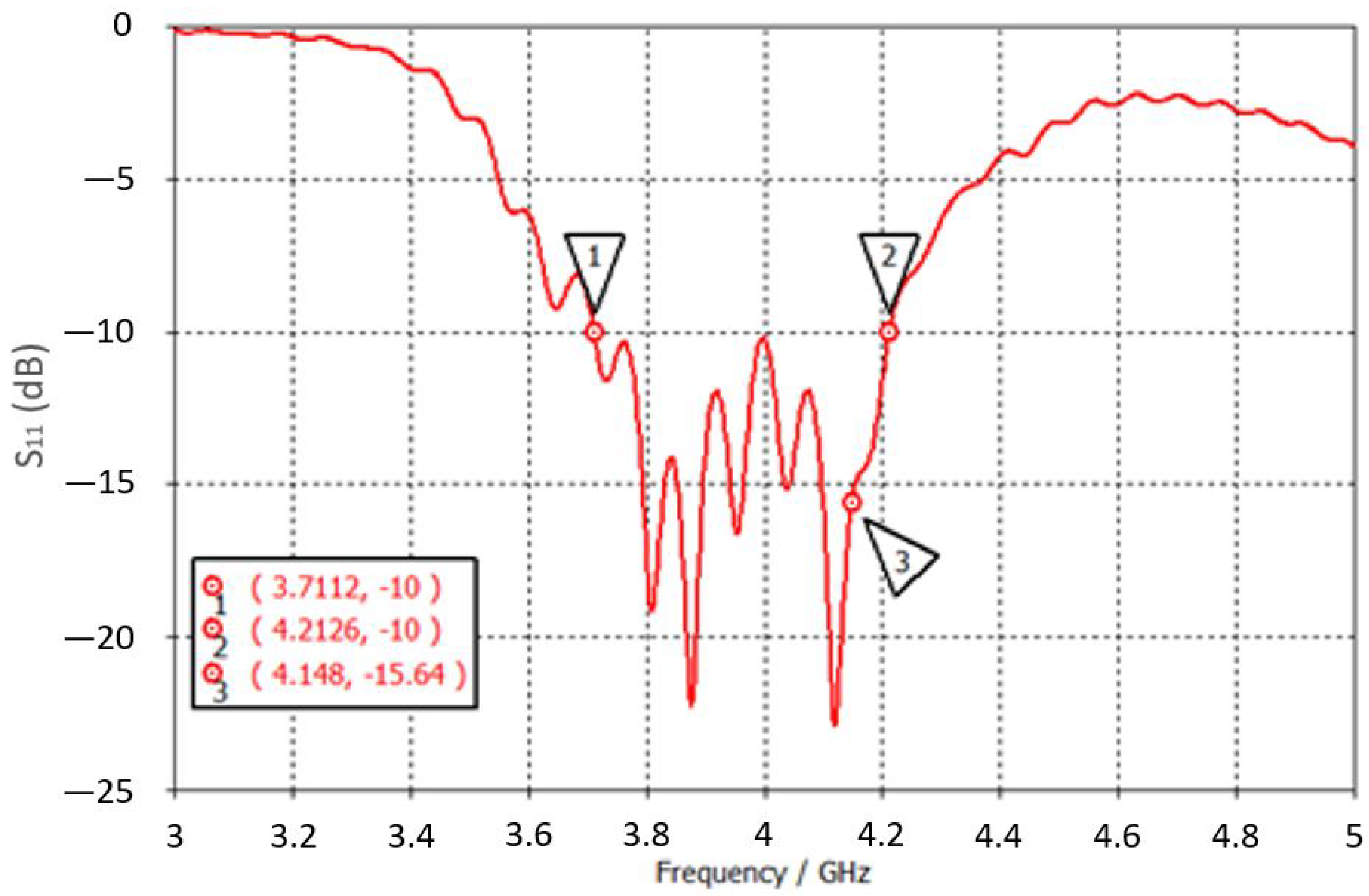
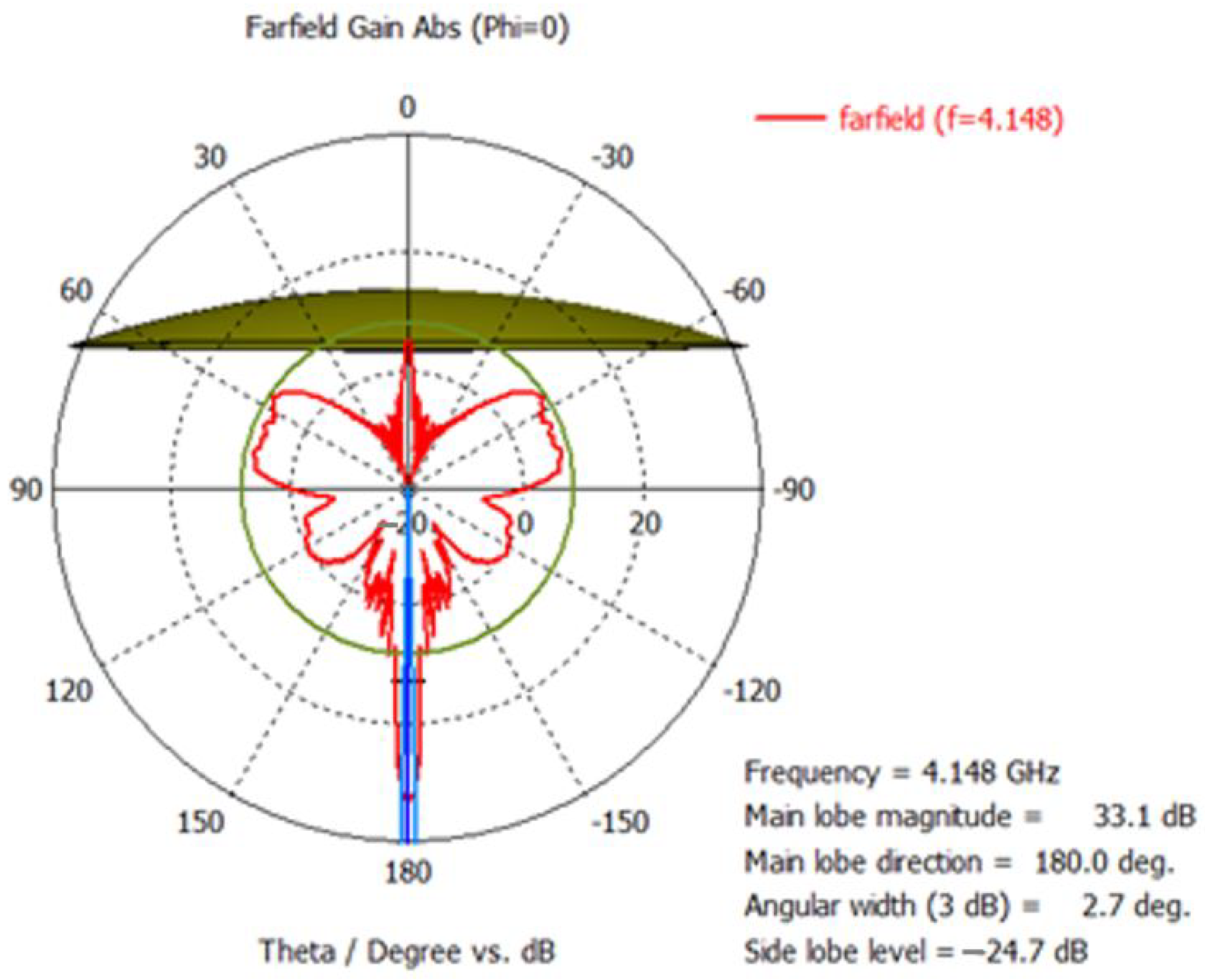

| Reference | Substrate | Dimension (mm) | Frequency | Gain |
|---|---|---|---|---|
| [29] | Rogers RT 5880 | 17.79 × 21.96 × 1.6 | 8.864 GHz | 5.09 dB |
| [30] | RT/Duroid 6002 | 74 × 74 × 1.524 | 5.86 GHz | 13.34 dB |
| [31] | FR4 | 80 × 80 × 1.6 | 5.7 GHz | 6.16 dBi |
| 7.6 GHz | 2.5 dBi | |||
| Proposed | RT/Duroid 5880 | 120 × 85 × 3.255 | 4.148 GHz | 12.1 dBi (w/o refl.) |
| 33.1 dBi (w/ refl.) |
Disclaimer/Publisher’s Note: The statements, opinions and data contained in all publications are solely those of the individual author(s) and contributor(s) and not of MDPI and/or the editor(s). MDPI and/or the editor(s) disclaim responsibility for any injury to people or property resulting from any ideas, methods, instructions or products referred to in the content. |
© 2023 by the authors. Licensee MDPI, Basel, Switzerland. This article is an open access article distributed under the terms and conditions of the Creative Commons Attribution (CC BY) license (https://creativecommons.org/licenses/by/4.0/).
Share and Cite
Apriono, C.; Mahatmanto, B.P.A.; Juwono, F.H. Rectangular Microstrip Array Feed Antenna for C-Band Satellite Communications: Preliminary Results. Remote Sens. 2023, 15, 1126. https://doi.org/10.3390/rs15041126
Apriono C, Mahatmanto BPA, Juwono FH. Rectangular Microstrip Array Feed Antenna for C-Band Satellite Communications: Preliminary Results. Remote Sensing. 2023; 15(4):1126. https://doi.org/10.3390/rs15041126
Chicago/Turabian StyleApriono, Catur, B. Pratiknyo Adi Mahatmanto, and Filbert H. Juwono. 2023. "Rectangular Microstrip Array Feed Antenna for C-Band Satellite Communications: Preliminary Results" Remote Sensing 15, no. 4: 1126. https://doi.org/10.3390/rs15041126





